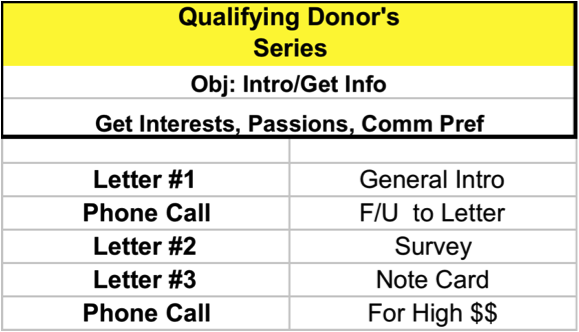I hope you’ve had a chance to read my previous post on why it’s important to qualify every major donor on your caseload.
Discussing qualifying donors makes me think about our everyday relationships and friendships. Usually, you don’t just decide to make someone your friend the first time you meet him or her. There may be a couple of characteristics you’re attracted to at first, but you do a few things before deciding if this person is really going to be your friend.
First you might invite them to have coffee or a beer (my favorite). Then if that goes well, perhaps you invite them to a meal or to an event. Each interaction helps as you judge whether you continue on in the relationship. And, if you’ve got a decent enough EQ, you’ll pick up clues from the other person if they are interested in you.
It’s kind of a little dance we all play. But a necessary one.
Well, the same is true about our donors. They tell you a lot by their behavior at first. How many times have they given to your organization? How large are their gifts? When was the last time they gave? All of these are clues about the relationship they want with you.
However, as I said in the last post, these clues are not telling us everything. Which goes back to what I said about meeting a $$ Criteria. A non-profit who assumes someone is a major donor and wants a deeper relationship with you because they met your $$ criteria is like a person coming up to you, smiling and saying, “hi,” means they want to be your best friend.
It might not mean they want a deeper relationship at all with you. But for whatever reason, many non-profits act like that socially awkward person (and we all know one) who thinks if you smile at them, somehow that means you’re their new best buddy.
Okay, so I promised some practical advice. How do you qualify a donor? Here is how we do it at Veritus Group:
#1 — Review everyone who has met your major gift criteria as relates to current giving. That might be $500 cumulative YTD, $1000 cume YTD, or more. We call this measurement “inclination.” How is your current donor currently giving, and does it show an inclination to give? Next, look at capacity. What is their ability to give? Use any of the wealth indicators to get to this information. It is the confluence of INCLINATION and CAPACITY that gives you the clue that the donor meets YOUR metric.
#2 — If they meet your metric, then it’s time to qualify. Here is a way to do it:
- Send an introductory letter — explain who you are, thank them for past support, and say that you want to contact them about their interest in X organization and that you will be calling within the next week.
- Phone Call — In the phone call, you tell the prospect you’re following up on your letter, that you have been assigned as their personal representative, you thank them for all their past support and you would love to get to know what they are most passionate about regarding X organization. If the donor is forthcoming, try and find out what other organizations they love, why they like your organization, how they would like to be communicated with in the future and if appropriate, could you sit down to meet with them sometime.
- Survey Letter — If you cannot get them on the phone after a few tries, leave a message letting them know you called and give your phone number. If after a week you do not hear back, we advise sending out another personal letter asking for their feedback in a personal survey. This survey asks questions about the donors passions, what they like about the organization, what programs they like the most, how they want to be communicated with, etc. Basically, all that you were going to ask in the phone call. Make sure you send a stamped reply envelope to make it easy for them to respond.
- Final notecard — If you still haven’t heard from them, you may want to send one final notecard, handwritten, asking the donor how they would like to be communicated with, and let them know your contact information.
- Final Phone Call — We would reserve this for those high-dollar donors that you have yet to hear from.
Okay, I said I would provide a graphic, so here it is:

Now, remember that you’re going to find that roughly 1/3 of the donors you contact are going to want a more personal relationship with your organization. But there is nuance at play here. What I mean is that many donors you are cultivating already have a relationship with you. You know they will be on your caseload, so you don’t need to go through this whole process. However, sending them a survey or phoning them to thank them and follow up with good questions is a good thing.
I’ve seen caseloads of 450-500 people on them. That’s a disaster waiting to happen! This process is perfect to get you down to the 150 you can actually manage and serve well. This process works great for the small non-profit where only the Executive Director is cultivating major donors.
In fact, I just helped a small non-profit take a list of 150 potential major donors and got his caseload down to 45 – a number he can handle with all his other work. Just this process alone helped raise over $40K in new revenue because the Executive Director took the extra time to get in touch with donors.
That is another of the added benefits of this Qualifying Process: donations, and a ton more information about your donors. There are only positives that come out of this process. You get donors who WANT to be cultivated in a personal way, you obtain revenue you didn’t expect, and you find out what your donors are most passionate about.
Awesome, right? Now, go out and QUALIFY!
Added bonus: If you’d like a FREE copy of our white 8-page white paper that gives you actual examples of letters to send and added context on how to qualify your file, click here.
Jeff




I can’t believe I only recently discovered you/this blog. I’m in love! And I most definitely want to qualify so expect an email from me.
great advice, in this qualification process, I notice that you don’t meet with prospects, is that because of both time and cost reasons?